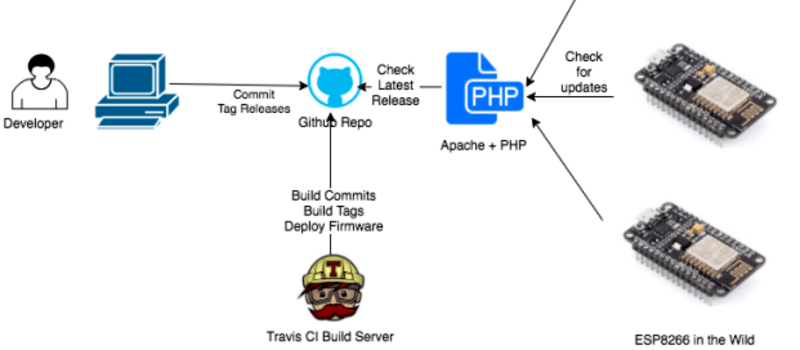There’s nothing to be ashamed of. It’s a problem we all have. You change your code a lot — you can’t help it, you just need to tweak one last little bit. And then you have to go downstairs, fetch your ESP8266 module, plug it in to your computer, flash the new firmware in, and then run back down and re-install your wine-cellar temperature monitor. If only there were a way to continuously update your ESP8266 over the air, pulling new code down from your GitHub repository, automatically running your test suite on it, and then pushing it off to the ESP.
OK, it’s ridiculous overkill, but [squix] strung together a bunch of open-source continuous integration tools and made them work with the ESP8266. A simple PHP script connects the ESP to the rest of the web infrastructure.
[squix] says the word “security” in the same way that gin aficionados whisper “vermouth” over their Martinis. Which is to say, there is none. But for a home solution, or if you want to play around with continuous development, it’s a good start.
And this is a cool project because it makes use of the ESP8266 OTA (over-the-air) programming library to push the code across. And we do hate having to run around the house to update firmware.
So check it out if you want to push code to your ESP8266s without physically going to fetch them, or if you want to integrate your web development with your home deployment.
















I’m working on a project that will utilize 30 or more ESP modules (I’m actually using the WeMOS D1 Mini, a great little board and quite cheap in quantity). I was aware of OTA updating, but didn’t realize how easy it is. A simple tie-in with MQTT and I can trigger an update at will. The MQTT message could even contain the exact firmware file I want it to use. I like it. I’ll be adding OTA (although not nearly this complex) support very soon.
This is really neat OTA programming is still quiet unique in the hobbyist world and is sure to become the most conveient way of programming WIFI based devices.
I’m waiting for the ESP32 and a complete Micropython port for it!. To me this would be truly a killer combination! Hardware-wise it is low cost, easy to program (OTA or over serial port), have plenty of IO and processing power.
Software-wise Micropython would make it even more accessible to novice programs than even the arduino Libs!
>Hardware-wise it is
no it _is not_, as you said you are waiting for it because .. it doesnt exist yet
-no full datasheet available
-no price set
This is great, managing the edge of an IOT network in the same way that you manage the core Linux boxes is very useful, if you can do it securely.
PHP? JHC!